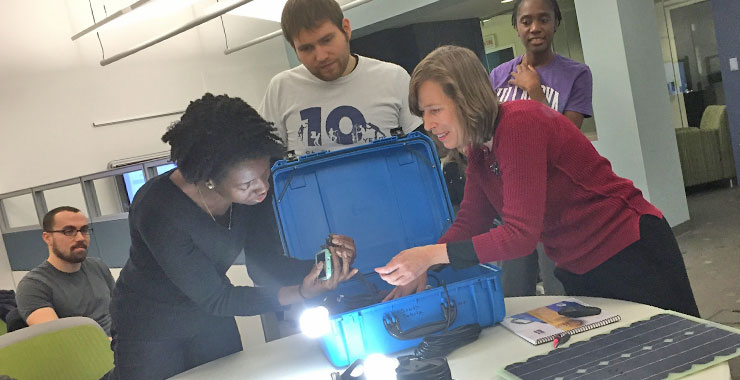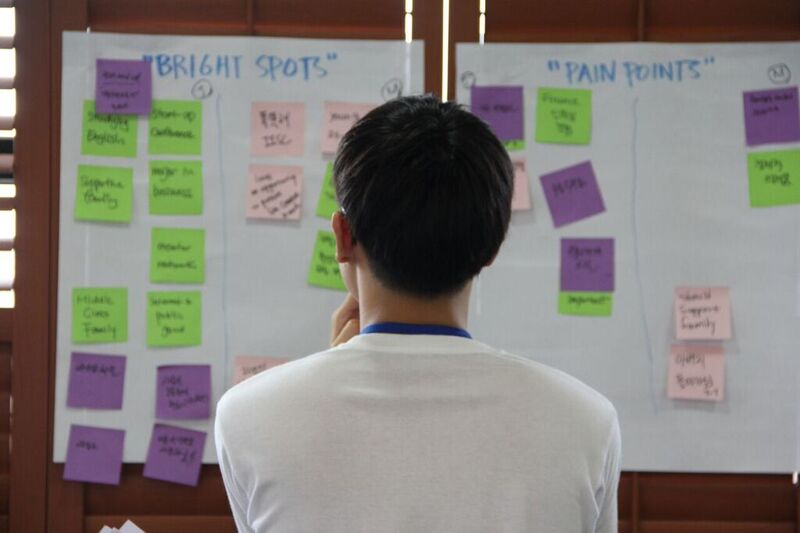How Design Thinking and Interdisciplinary Education Can Change the World

Why are Net Impact chapters building hydroponics systems, 3D-modeling showerheads, and collaborating with hardware social enterprises? Last fall, we launched the Impact Design initiative in response to member requests for more experience in impact design – a field rooted in the belief that design principles and interdisciplinary collaboration are critical tools to solve challenges around the globe. Our existing chapters are adding creative programming, and new design and STEM schools are launching chapters – with awesome results. We were thrilled that our friends over at Line//Shape//Space wanted to tell our story. Read the story by Matt Alderton below and find out how to get involved in Impact Design here!
Changing the World with Design Thinking
A new generation of designers is emerging on college campuses around the world. It’s not just a new wave of design, but how it’s done and, ultimately, the end product. The problem? It’s currently an uphill battle to get the resources and networks needed to reach these students’ core goal, especially while still in school. And that goal is about helping to make the world a better place.
Net Impact, an Oakland, Calif.-based nonprofit with more than 80,000 student and young professional members whose goal is creating social and environmental “impact” on college campuses and in the workplace, surveyed design and STEM students and found that 88 percent are interested in gaining skills and experience in “impact design”—using the power of design to create social and environmental impact—while 77 percent are interested in interdisciplinary collaboration.
“Wherever you work, you probably have people from all different disciplines coming together around a common goal through meetings and projects,” says Linda Gerard, Chief Community and Innovation Officer at Net Impact. “That’s the way the real world is structured, and students should have that same opportunity.”

At some universities they do. Unfortunately, at many they don’t. “We can’t speak for all schools, but our research has shown that at some large research universities, in particular, it can be challenging to work in an interdisciplinary way because of how they’re funded, set up and structured,” Gerard explains.
Because it can be very difficult to change institutions, but easier to change the people inside them, Net Impact and organizations like VentureWell are leveraging students to break down siloes and encourage faculty, student, and business connections.
“We believe that working with students from the bottom-up can be a really powerful way to begin to break down those barriers in ways that can be difficult to do in a top-down fashion,” Gerard continues.
The Emerging Importance of Design in Business
The role of design is a true business demand that presents new job opportunities. Take for instance the growing trend of corporations introducing C-level “Chief Design Officer” positions. “Design with a capital ‘D’ isn’t just for designers anymore,” Gerard states. “Everyone—whether you work for a nonprofit, a social enterprise or a business—needs to understand how to design.”
Indeed, products aren’t the only things that demand design. Like a toothbrush, a skyscraper, a lamp, a Lamborghini, or a blouse, business models, programs, projects and even services must be designed and engineered in order to be successful. “A lot of the principles that come from the world of product design are broadly applicable and used increasingly by people of all walks of life,” Gerard says.
Those principles include concepts like human-centered design, which is design that’s laser-focused on creating processes, products, and experiences that satisfy the unmet needs of human beings. And when designers and non-designers alike practice design thinking—everyone from architects and fashion designers to CEOs and scientists—it has the potential to help humanity solve problems like water scarcity and climate change.
“Every company and every social enterprise faces a design challenge,” Gerard explains. “Whatever business you’re in, on a fundamental level it requires having a deep understanding of the problems people face and coming up with creative solutions to address them.”
The Impact Design Initiative
Net Impact’s Impact Design Initiative promotes impact design by helping students build interdisciplinary networks that facilitate design thinking and business acumen on both sides. Introduced in 2015 through a partnership with Autodesk Foundation, the first year is focused on launching and seed-funding up to 20 new Design/Stem Net Impact chapters on college and graduate campuses nationwide; creating value-added programming that bring together the Design/STEM  chapters with existing Net Impact business chapters; and introducing opportunities and programs for STEM,design, and business students to collaborate at Net Impact’s annual conference.
chapters with existing Net Impact business chapters; and introducing opportunities and programs for STEM,design, and business students to collaborate at Net Impact’s annual conference.
Net Impact’s University of California, Berkeley Haas Business School chapter’s collaboration with the Net Impact Social Engaged Engineers chapter on campus perfectly illustrated the Impact Design Initiative’s purpose and potential in September 2015 when they co-hosted the initiative’s inaugural chapter event: a sold-out 24-hour “Design-a-thon” sponsored by the Autodesk Foundation during which teams of business and design students used human-centered design methodologies to brainstorm products, services, and processes that would help solve California’s historic drought. The winning team, team “DripIt,” used Autodesk Fusion 360 to design a product that makes people more cognizant of their impact on the drought by offering them a visual representation of the amount of water required to create their favorite food dishes from start to finish.
“The students came up with some amazing design solutions to a very big challenge,” says Gerard, who says other Net Impact chapters are organizing similar events, as well as lecture series and campus and community projects intended to teach and illustrate impact design in an interdisciplinary manner. “And in the process they came away with a deeper understanding of how design can be used to solve real-world problems.”
